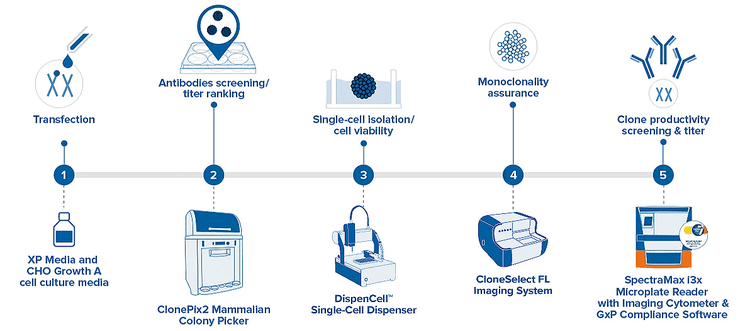Cell Line Development
Stable cell lines are widely used in a number of important applications including biologics (e.g. recombinant protein and monoclonal antibody) production, drug screening, and gene functional studies. The process of developing stable cell lines often starts with transfecting selected host cells, typically CHO or HEK 293 cells, with desired plasmids. After transfection, researchers then screen and quantify high-expressing clones. Once these high producers are identified, the cell lines and/or the proteins produced by the cells are validated.
The manual screening methods traditionally used for cell line development are time-consuming and labor-intensive, creating a great demand for high throughput, automated solutions for such efforts. The general workflow below helps identify the systems that can aid in your research.

Cell line development process:
- Transfection is the process of introducing a foreign DNA (encoding the recombinant protein of interest) into a host cell. A small population of cells with the foreign DNA integrated into their genome that maintain their ability to express recombinant protein for long periods of time are referred to as stably transfected cells.
- Antibodies screening/titer ranking – Discovery and selection of high-value clones from a transfected pool of cells. To screen large populations by quantifying cell surface expression of protein-of-interest or secreting antibodies (titer ranking) will increase the probability of finding rare high-affinity binder or high producer.
- Single-cell isolution and cell viability – Single, viable cells must be isolated and cloned in order to ensure that the cell population is genetically identical, significantly reducing the heterogeneity of expression
- Monoclonality assurance – When developing cell lines for biotherapeutics, it is crucial from a quality and regulatory perspective to ensure that the cell line originates from a single progenitor and is therefore monoclonal. Documentation of monoclonality (a regulatory metric for therapeutic cell lines) is typically image-based, whereby an image of a single cell is recorded and included in regulatory filings.
- Clone productivity screening and titer – This is a test that detects the amount of recombinant protein or antibodies produced from the clonally-derived cell line.
